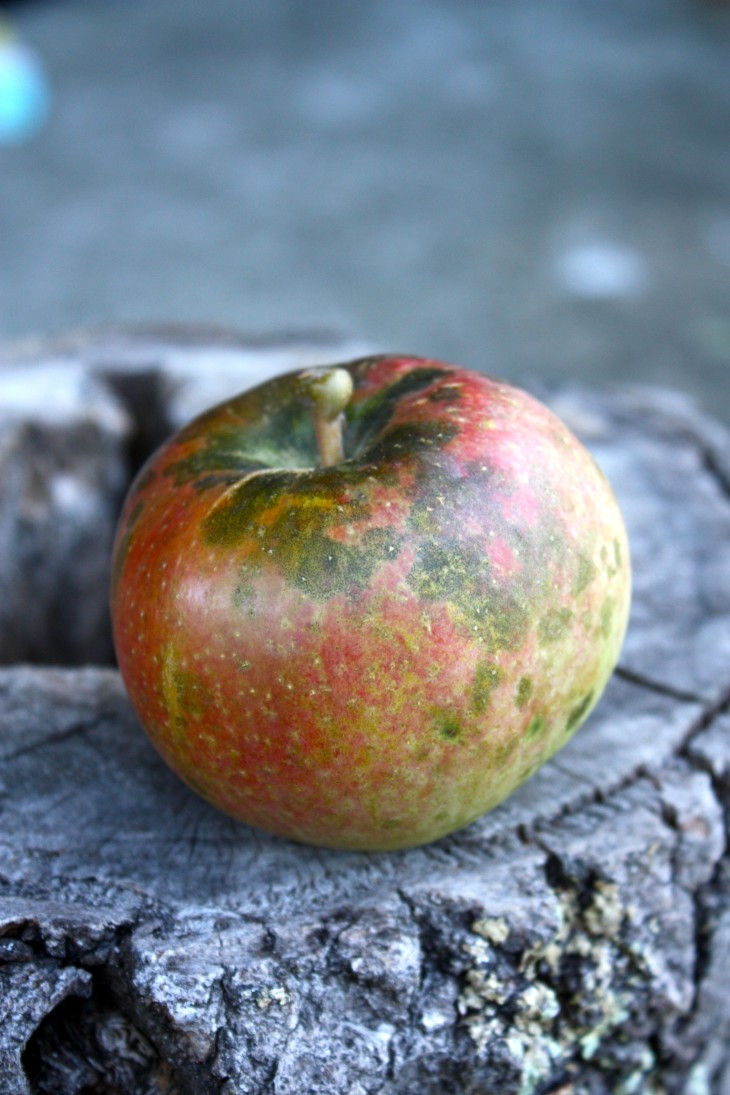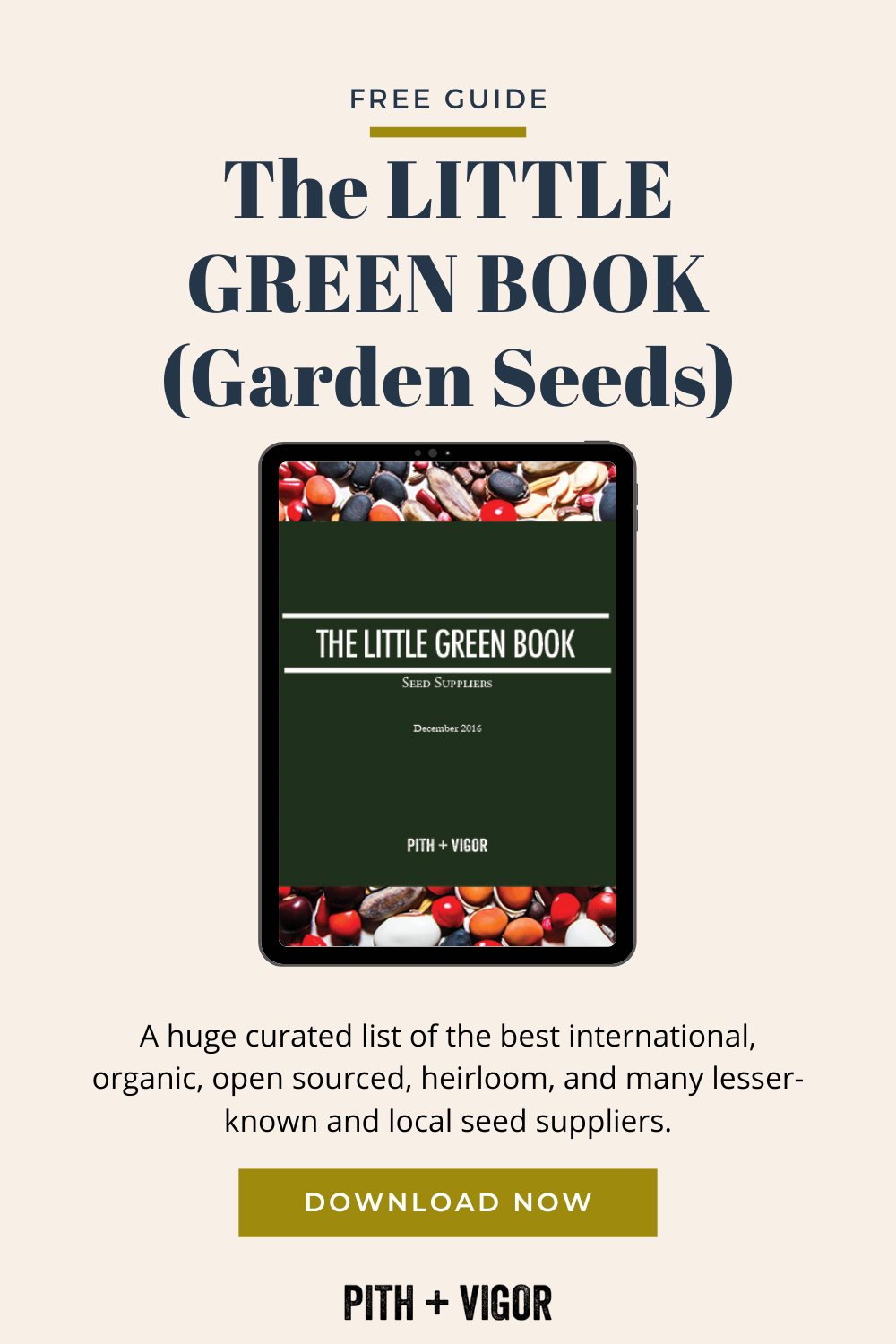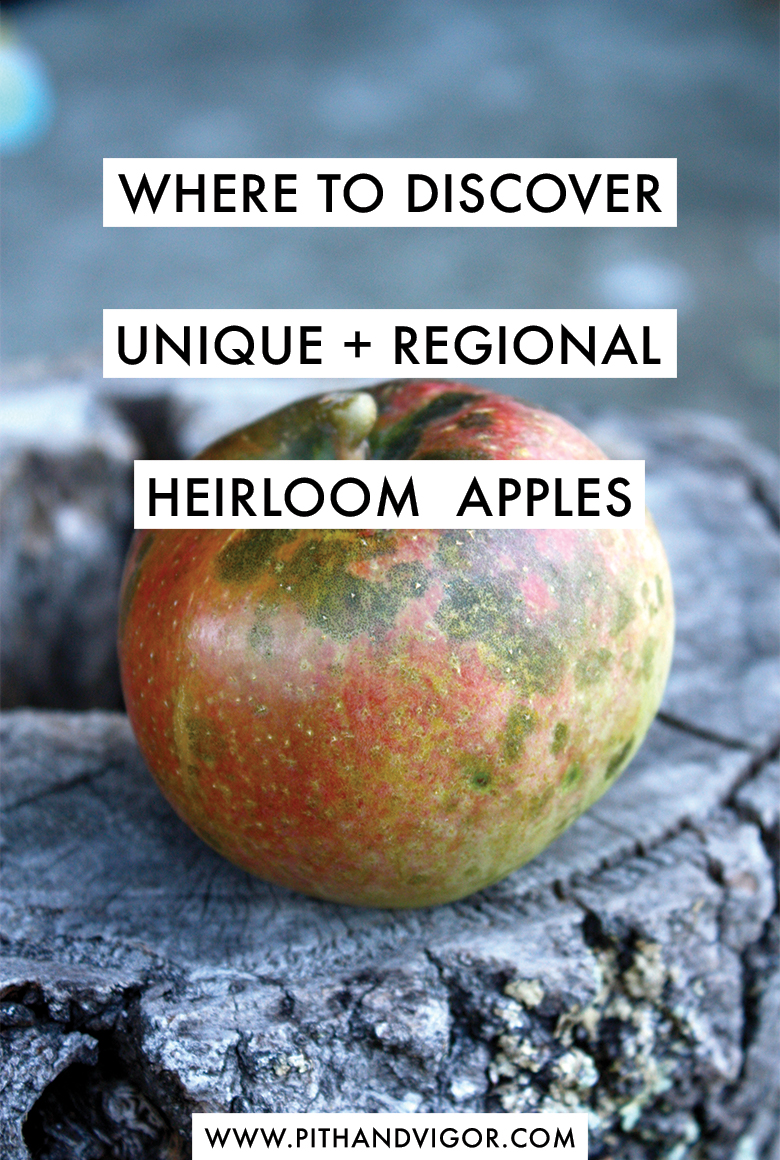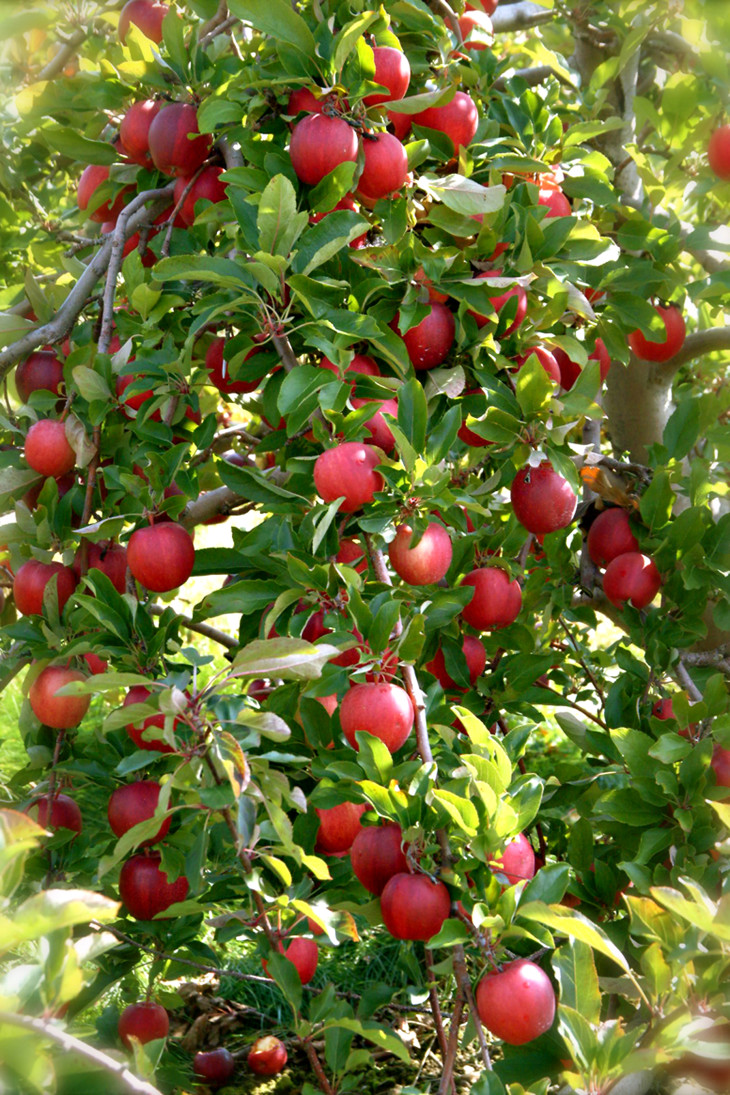My apple repertoire was limited before I moved to New England. I grew up in Colorado, so I think I’m excused for not knowing there was more than Red Delicious. (which I never liked). But New Englanders (and I suspect those who live in other heirloom and heritage apple growing regions as well), all know their distinctive favorites and the more obscure and rare the apple variety, the more ‘Yankee cachet’ your selection brings.
Supporting the growers of regional heirloom fruit is not just a way to flex your insider status and upgrade your pie making – but it also supports valuable biodiversity. You could even plant your own heirloom apple trees (they are beautiful in the garden and easy to grow!).

Homegrown heirloom apples
I grow six heirloom apple varieties in my garden (two singular trees + a third with a 4-way graft), and recently, when my dad, my son, and I picked them, we held an impromptu taste test along the way. Our favorite from our selection was a tie between Cortland and Macintosh (with Empire and Honeycrisp in hot pursuit). It takes forever to feel like you aren’t new when you move to New England (I’ve lived here nearly 20 years, and I still feel a little like an outsider…), but knowing our favorites of the locally grown regional apples certainly helps to solidify our Yankee cred.
As the summer closes and the holidays approach, we are headed into the fall apple-picking season. When the weather gets colder, the freshest fruit produce available will be apples. (They can be stored all winter in a cool, dry place). Big grocery chains rarely carry the best regional varieties from across all the apple-growing regions of the USA. To really know regional heirloom apples and heritage fruit, you usually have to visit farm stands and orchards directly.
So, if you are traveling, look out for them and others. Take the time to delve into the fun backstories of some of the trees – there is a lot of history buried there…
…..
A Little Apple-Growing US History…
Back in the day of our local apple-growing hero, Johnny Appleseed, biodiversity and natural selection gave rise to a vast selection of regionally variable apples. At one time, heritage apple varieties numbered over 15,000. Today, however, industrial farming produces 90% of apples. Only 11 apple varieties are commonly found in most grocery stores.
But what is the other 10%? That is where the joy is. The search for the best, regional, lesser-known and more interesting varieties can provide a grand day full of adventure, exploring, taste-testing, and maybe even a history lesson.
Heritage Apple Regions in the USA
Apple growing regions in the United States extend from Michigan and the Great Lakes through New England, from Virginia and North Carolina and the neighboring mountain valleys into the Ohio Valley, and throughout the Pacific Northwest and into California. What is now referred to as heirloom, vintage, or antique varieties of apples were once common in early America. In most areas, unless you travel to local apple-picking orchards and participate in the traditions of cultivating and harvesting apples, you may never see or taste the fruits whose unique character shaped early American life.
There are about 5,000 remaining apple varieties that round out the non-industrial market. Many are endangered but can be purchased through local nurseries and growers. If you discover a new favorite, try planting it. In doing so, you will contribute to retaining valuable biodiversity and regional history.
Where to buy Heirloom apple trees
To grow your own heirloom apples, you will need propagation material and trees. Find all the supplies from these fine growers:
- Fedco Seeds – Waterville, Maine
- Shelburne Orchard – Shelburne, Vermont
- Gould Hill Farm – Hopkinton, New Hampshire
- Clarkdale Fruit Farm – Deerfield, Massachusetts
- Eastman’s Antique Apples – Wheeler, Michigan
- Heritage Apple – Clemmons, North Carolina
- Big Horse Creek Farm – Lansing, North Carolina
- Urban Homestead – Bristol, Virginia
- Vintage Virginia Apples – North Garden, Virginia
- Foggy Ridge Cider – Dugspur, Virginia
- Jones Creek Farm / Skagit Valley Fruit – Sedro Woolley, Washington
- Trees of Antiquity – Paso Robles, California
Also, for more information about heritage, antiques, and heirloom apples, visit Noble Fruits: A Guide to Conserving Heirloom Apples.
Additionally, here is a list of 28 great heirloom seed suppliers where you can find an abundance of exciting things to add to your garden.
REGIONAL HEIRLOOM APPLES
A few years ago, I researched some lesser known regional varieties with interesting characteristics and history that are worth watching out for (see the list below). If you have any others to add, let me know, and I will update!
California & the Pacific Northwest Heirloom apples
The Gravenstein is thought to have arrived in western North America with Russian fur traders, and it is well-suited to coastal locations.
Chehalis was discovered in Washington in 1937, and Sierra Beauty was originally discovered on the slopes of the Sierra Nevada Mountains of California in the 1890s. Both are thought to be a remnant of miners during the California Gold Rush. Sierra Beauty has since disappeared and been rediscovered twice, but is now found throughout California.
Where to find Heirloom fruit in the Great Lakes & Mid-West
Brier (Sweet) Crab was originally propagated after the Civil War in Baraboo, Wisconsin. It is pale yellow with red streaks, very sweet, and good for desserts or for making applesauce.
Eureka and Salome are both pippin apples—that is, they are “volunteers” that grew spontaneously from the seed of a dropped apple. Eureka first grew beneath a Tolman Sweet apple tree. Salome was discovered in an abandoned nursery in Illinois, and the founder named it for his mother.
Another regional favorite is the very large McMahon that is believed to be the offspring of the (also very large) Alexander apple. McMahons date to 1860 in Richland County, Wisconsin. The Alexander apple can be traced back from England to Russian heritage.
Appalachian Region Heritage Apples
Dula Beauty was first grown in Lenoir, North Carolina, from the seeds of the Limbertwig. It grows very well in the region, has been recommended by the North Carolina Department of Agriculture since the turn of the 20th century, and is popular for frying and baking.
Hall is a small apple whose flavor has hints of vanilla. Many antique apples exhibit flavors that vary from butterscotch to anise and other spices.
Junaluska was the leader of the eastern band of Cherokee Indians that lived in North Carolina. The apple tree named for him hailed from his land in western North Carolina. It was considered extinct until 2001, when it was rediscovered by Tom Brown of Heritage Apples.
Reasor Green was also thought to be extinct until 2001. Originally from Lee County, Virginia, the tree produces fruit uniquely capable of drying—instead of rotting—when wounded.
Mid–Atlantic Heirloom Fruit Growers
Campfield was well-known in early America because of its usefulness in cider-making. During Colonial times, Campfied juice was combined with juice from Harrison Cider Apples and Graniwinkles. Harrison Cider Apples, when unmixed, make a dark, extremely rich cider that is in great demand.
Willow Twig is another rare apple, named for the unique drooping and willow-like appearance of the tree.
New England Regional Heirloom Apples
Aunt Penelope Winslow is a fall apple, ostensibly brought to Maine’s North Haven Island from Marshfield, Massachusetts, over 200 years ago by a woman referred to as Aunt Penelope.
Cole’s Quince was discovered by Captain Henry Cole in Cornish, Maine, around 1840. It was called “quince” because of its shape and coloring, and its flavor is described as tart, tangy, aromatic, and zesty.
Golden Russet (also called Wheeler’s) is prized for its rich, spicy flavor and was at one time called the “champagne of old-time cider apples.”
Renowned and rare, Esopus Spitzenburg apples were Thomas Jefferson’s favorite. The Esopus Spitzenburg apple is named for where it was discovered (Esopus, Ulster County, New York – not sure where the Spitzenburg part comes from?), and it is considered one of the best rare apples for making apple pie.
Read Also>>> 10 Really Great Heirloom Seed Companies for USA and Canada

Get PITH + VIGOR’s Little Green Book – Seed Suppliers. This huge list contains more international, organic, open-sourced, heirloom, and many lesser-known and local seed suppliers.
It is great for finding local sources for Heirloom apple trees and other heritage fruit trees.
More Apple-related posts:
images top Isaac Greayer, bottom Kelly Fitzsimmons
Share this Post:


Ordering Gravenstein and Chehalis now for my mom’s backyard 🙂
Exciting! Good Luck!
I had no idea there were so many different types of apples! Now I want to try them all… apples are one of my favorite fruits, and I’ve been missing out on so many varieties all this time. I guess that’s what happens when you live in Indiana!
Angie – Indiana is where Johnny Appleseed ended his notorious trail! There should be lots apple varieties around your area! Look at the local little guys – I am sure that there must be a treasure trove hiding.